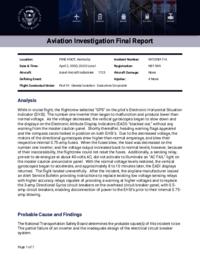
This information is added by users of ASN. Neither ASN nor the Flight Safety Foundation are responsible for the completeness or correctness of this information.
If you feel this information is incomplete or incorrect, you can submit corrected information.
| Date: | Sunday 2 April 2000 |
| Time: | 20:30 LT |
| Type: |  IAI 1125 Astra |
| Owner/operator: | Ssw Jet Limited |
| Registration: | N511WA |
| MSN: | 034 |
| Total airframe hrs: | 3755 hours |
| Engine model: | Airesearch TFE-731-3A |
| Fatalities: | Fatalities: 0 / Occupants: 4 |
| Other fatalities: | 0 |
| Aircraft damage: | None |
| Category: | Serious incident |
| Location: | Pine Knot, KY -
 United States of America United States of America
|
| Phase: | En route |
| Nature: | Executive |
| Departure airport: | Naples, FL (KAPF) |
| Cincinnati, OH (KLUK) | |
| Investigating agency: | NTSB |
| Confidence Rating: |
While in cruise flight, the flightcrew selected "GPS" on the pilot's Electronic Horizontal Situation Indicator (EHSI). The number one inverter then began to malfunction and produce lower than normal voltage. As the voltage decreased, the vertical gyroscopes began to slow down and the displays on the Electronic Attitude Display Indicators (EADI) "blacked out," without any warning from the master caution panel. Shortly thereafter, heading warning flags appeared and the compass cards locked in position on both EHSI's. Due to the decreased voltage, the motors of the directional gyroscopes drew higher-than-normal amperage, and blew their respective internal 0.75-amp fuses. When the fuses blew, the load was decreased on the number one inverter, and the voltage output increased back to normal levels; however, because of their inaccessibility, the flightcrew could not reset the fuses. Additionally, a sensing relay, pre-set to de-energize at about 40-volts AC, did not activate to illuminate an "AC FAIL" light on the master caution annunciator panel. With the normal voltage levels restored, the vertical gyroscopes began to accelerate, and approximately 8 to 10 minutes later, the EADI displays returned. The flight landed uneventfully. After the incident, the airplane manufacturer issued an Alert Service Bulletin providing instructions to replace existing low voltage sensing relays with higher accuracy relays capable of providing a warning at higher voltages and to replace the 3-amp Directional Gyros circuit breakers on the overhead circuit breaker panel, with 0.5-amp circuit breakers, enabling disconnection of power to the EHSI's prior to their internal 0.75-amp blowing.
Probable Cause: The partial failure of an inverter and the inadequate design of the electrical circuit breaker system.
Accident investigation:
 |
|
Sources:
NTSB NYC00IA116
Location
Revision history:
| Date/time | Contributor | Updates |
|---|---|---|
| 03-May-2024 10:19 | ASN Update Bot | Added |
Corrections or additions? ... Edit this accident description
The Aviation Safety Network is an exclusive service provided by:


 ©2024 Flight Safety Foundation
©2024 Flight Safety Foundation